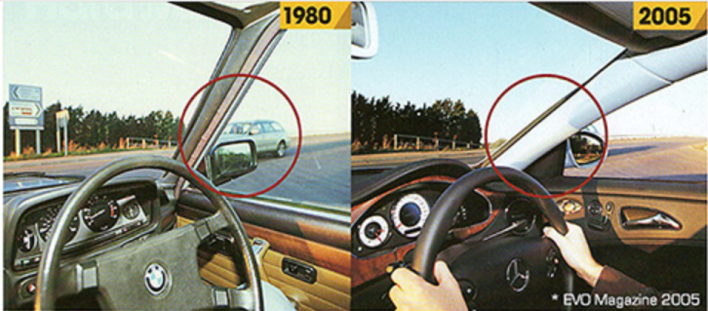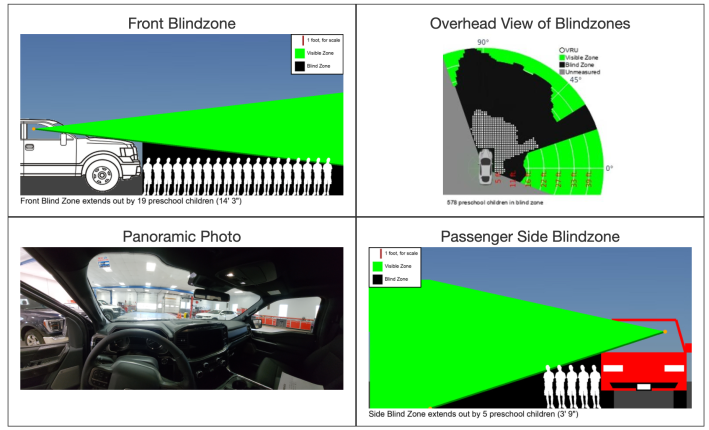SUVs and pick-up truck drivers are three to four times more likely to hit a pedestrian when they make a turn than the drivers of smaller cars, a new study finds — and researchers think it's because federal regulators aren't scrutinizing the common design features that make it impossible for megacar drivers to see walkers passing right in front of them.
In a new study of federal crash data by the Insurance Institute of Highway Safety, researchers found that crashes in which a driver kills a walker are three times more likely to involve a left turn if that motorist was piloting an SUV at the time of impact, compared to fatal walking crashes involving the drivers of smaller cars.
Fatal crashes involving pick-up truck drivers, meanwhile, are four times more likely to involve a driver making a left — and when it comes to right-turn crashes, they're still 89 percent more likely. Right-turning SUV drivers are 63 percent more likely to strike a person than the drivers of smaller vehicles.
And yes: all those numbers were adjusted for a broad range of systemic factors, including the age and gender of the motorists and walkers involved, whether the crash occurred in an urban or rural area, and key design features of the environment in which the crash happened, like whether the roads were well-lit. That means that the physical design of megacars themselves may be increasing the likelihood of their drivers' hitting walkers — and when that happens, those cars are generally about two to three times more likely to kill, as earlier researcher has shown.
Those dramatic numbers add to the mountain of evidence that America's fast-growing fleet of ever-larger megacars are not just more dangerous to pedestrians when they're going straight at high speeds, but in a variety of common roadway situations — and that the many design features that make them so dangerous are in urgent need of regulation.
In particular, the researchers behind the study cited the design of a vehicle's A-pillars — the vertical struts on either side of the windshield that connect the roof to the body of the car — which create a pair of potentially deadly blind spots for drivers. The larger the megacar, the wider and more visually obstructive its A-pillar, a feature which automakers say is necessary to prevent rollover crashes, though experts argue they could achieve the same occupant safety goals by making A-pillars out of stronger materials, while still keeping them skinny.
"This study points to another way to understand how the increasing popularity of SUVs could change the pedestrian crash picture," said Dr. Wen Hu, senior transportation research engineer for the Institute. "We really need to systematically study the impact of A-pillar design on pedestrian visibility."

Of course, A-pillars aren't the only reason why megacars are so much more dangerous to walkers. A megacar's height, boxy front-end design, and even the angle of the windshield can also increase its blind spots, but neither federal motor vehicle safety standards nor federal consumer safety ratings require automakers to assess how these design elements impact pedestrian safety.
For instance, the massive blind zones of the 2021 Ford F-150, one of the most popular new cars sold in the U.S today, can fit a staggering 578 preschoolers if they crowd close together, according to a calculator sponsored by USDOT.

Hu is careful to point out that vehicle design isn't the only factor that determines whether a given driver will strike or even kill a walker, and that vehicle speed, in particular, plays an outsized role in both. Turning crashes at intersections, of course, tend to occur at lower speeds, but they also happen more frequently than other types of collisions, particularly in urban areas with dense, connected grids — so much so that some experts think left turns should be banned entirely in areas where lots of people walk, and that right turns shouldn't be allowed at red lights, either.
If those policies are implemented in concert with a broader Safe Systems approach, pedestrian lives could be saved — but vehicle design shouldn't be left out out of the strategy.
“Improving vehicle design, along with addressing road infrastructure and vehicle speeds, can play an important part in reducing pedestrian crashes and fatalities,” Hu said. “Our findings suggest that looking at the problem through the lens of vehicle type could also be productive.”







